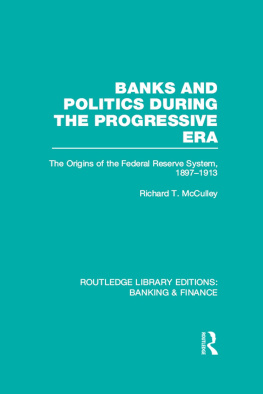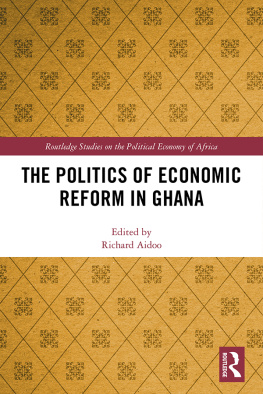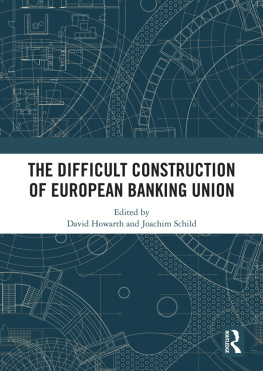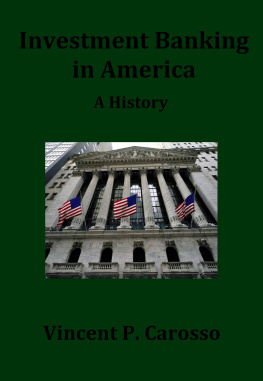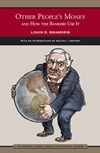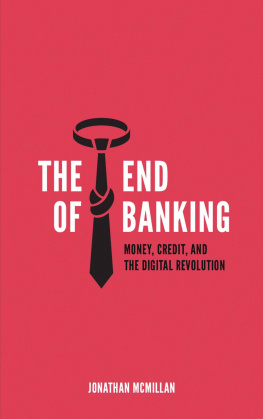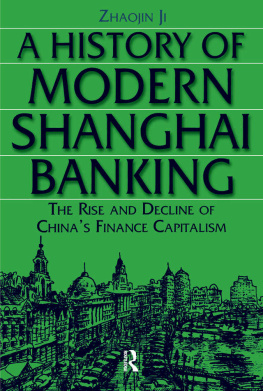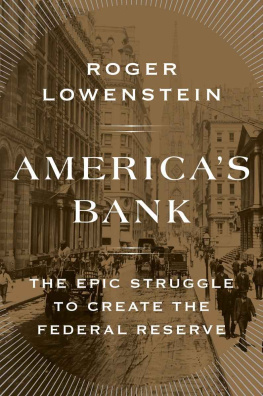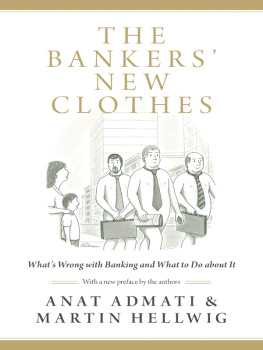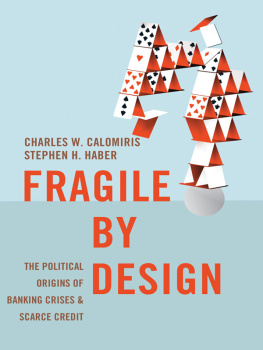ROUTLEDGE LIBRARY EDITIONS:
BANKING & FINANCE
BANKS AND POLITICS DURING THE
PROGRESSIVE ERA
BANKS AND POLITICS DURING THE
PROGRESSIVE ERA
The Origins of the Federal Reserve System,
18971913
RICHARD T. McCULLEY
Volume 21

First published in 1992
This edition first published in 2012
by Routledge
2 Park Square, Milton Park, Abingdon, Oxon, OX14 4RN
Simultaneously published in the USA and Canada
by Routledge
711 Third Avenue, New York, NY 10017
Routledge is an imprint of the Taylor & Francis Group, an informa business
1992 by Richard T. McCulley
All rights reserved. No part of this book may be reprinted or reproduced or utilised in any form or by any electronic, mechanical, or other means, now known or hereafter invented, including photocopying and recording, or in any information storage or retrieval system, without permission in writing from the publishers.
Trademark notice: Product or corporate names may be trademarks or registered trademarks, and are used only for identification and explanation without intent to infringe.
British Library Cataloguing in Publication Data
A catalogue record for this book is available from the British Library
ISBN: 978-0-415-52086-7 (Set)
eISBN: 978-0-203-10819-2 (Set)
ISBN: 978-0-415-52854-2 (Volume 21)
eISBN: 978-0-203-11688-3 (Volume 21)
Publisher's Note
The publisher has gone to great lengths to ensure the quality of this reprint but points out that some imperfections in the original copies may be apparent.
Disclaimer
The publisher has made every effort to trace copyright holders and would welcome correspondence from those they have been unable to trace.
BANKS AND POLITICS
DURING THE PROGRESSIVE ERA
THE ORIGINS OF
THE FEDERAL RESERVE SYSTEM,
1897-1913
RICHARD T. McCULLEY
GARLAND PUBLISHING, INC.
NEW YORK & LONDON
1992
Copyright 1992 by Richard T. McCulley
All rights reserved
Library of Congress Cataloging-in-Publication Data
McCulley, Richard T., 1946
Banks and politics during the Progressive Era : the origins of the
Federal Reserve System, 1897-1913 / Richard T. McCulley.
p. cm. (The Financial sector of the American economy)
Revision of the author's doctoral dissertation.
Includes bibliographical references and index.
ISBN 0-8153-0958-9 (alk. paper)
1. Monetary policy United StatesHistory. 2. Banks and bankingUnited StatesHistory. 3. United StatesHistory1865- 1921. 4. Board of Governors of the Federal Reserve System (U.S.) I. Title. II. Series.
HG501.M396 1992
332.1 120973dc20 92-27522
CIP
Printed on acid-free, 250-year-life paper
Manufactured in the United States of America
CONTENTS
PREFACE
From the adoption of the Constitution to the twentieth century, few issues stirred greater political passions than those surrounding money and banking. More than any other domestic issue, the debate over the establishment of the First Bank of the United States engaged the George Washington Administration and brought about the formation of the nation's first political parties. Andrew Jackson's destruction of the Second Bank of the United States was the most far-reaching political and economic event of his administration and crystalized the alignment of the first recognizably modern, mass political parties. Eclipsed by the slavery debate of the 1850s and the Civil War, controversies over the related issues of the war debt, national banks, greenbacks and the resumption of specie payments emerged during the 1870s and nudged aside Reconstruction issues. The century ended with the cathartic silver debate of the 1890s that brought to a close decades of political stalemate and propelled the Republicans to majority party status. When differences over financial issues contributed to the split of the Republican party in 1912, Democrats captured Congress and the White House and enacted the Federal Reserve Act of 1913, the most significant and enduring economic legislation of the Progressive Era.
Despite the political potency of money and banking issues, historians have largely dismissed the Progressive Era political debate over banking as irrelevant and have been preoccupied with explaining the shortcomings, limitations and inadequacies of the Federal Reserve Act. The unflattering picture that has emerged is one of bankers controlling the course of financial reform with the assistance of political leaders who were either subservient, hopelessly naive or insincere in their public opposition to bankers. While scrutinizing the role of bankers, this book places their exertions in a larger, unfolding political context and traces in an analytical narrative the interplay of sectional and economic interests, political ideologies and partisan clashes that shaped the course of banking reform.
Three political and ideological traditions grounded in the agricultural, commercial and financial sectors of the economy took distinctive shape in the early twentieth century. The Main Street tradition expressed rural, small town Americans adherence to a Jeffersonian distrust of banks and fear of concentrated financial power. This agrarian tradition championed government control of the money supply, believed the quantity of money directly affected prices and looked to the federal government as a counterweight to the power of urban bankers. Dominant in the Democratic party, the Main Street tradition was also powerful in the Republican party. La Salle Street bankers of Chicago and their urban, midwestern allies championed the laissez-faire tradition. During the Jacksonian Era laissez-faire burst onto the national scene and became the reigning sound money orthodoxy following the Civil War. Economists, academicians, the financial press, protestant clergy and the educated middle class swelled its ranks. The laissez-faire tradition harkened back to a pre-Civil War era when the federal government severed its relations with the financial sector and banks issued paper money. This tradition was a significant but not dominant force in both major political parties. After the demise of the Second Bank of the United States, the Hamiltonian tradition of economic nationalism lay dormant, but it found expression during the Civil War when Republicans passed the National Banking Act and reasserted a federal role in money and banking. The Hamiltonian tradition was based upon a nationally focused, centralized banking system and an alliance between government and finance that decisively tilted power toward private banking interests. More cohesive and disciplined than the Main Street or La Salle Street forces, Wall Street exponents of the Hamiltonian tradition occupied a strategic place in the nation's financial system. Wall Street was the dominant financial voice of eastern Republicans.
The interplay between these three traditions revealed the shifting political foundations of twentieth century American banking. While the relations of these traditions were predominantly conflictual, throughout the nineteenth century they overlapped, combined and reinforced each other to yield unanticipated and perverse outcomes. While the Progressive Era advocates of government control of banking and the money supply won a decisive victory on the political issues at stake, Democrats nonetheless left an ambiguous financial legacy because the Federal Reserve System could be bent to serve the interest of either one of these traditions under varying political circumstances.
I am extremely pleased to publish this revision of my doctoral dissertation as part of this series on the financial sector. This book makes no significant departures from my original analysis, interpretation or conclusion, but amplifies developments that I touched too lightly in the dissertation. I am especially indebted to Lewis L. Gould who lent the support and encouragement necessary to tackle a topic that I would have otherwise considered too intimidating. His valuable insights into Progressive Era politics and his careful reading of the dissertation improved it immeasurably. Walt W. Rostow stimulated my interest in economic history and was supportive in many ways. Forest G. Hill and Clarence G. Lasby read the manuscript and made valuable suggestions for improvement. Thomas K. McCraw read parts of the manuscript and contributed his deep insights into regulatory issues. Charles Franckle placed his expertise in banking at my disposal and made important suggestions for improvement. All students of American banking are indebted to the late Fritz Redlich. He generously shared his understanding of the role of ideas and ideology in the shaping of nineteenth century banking. I would also like to express my appreciation for the assistance of highly professional and courteous library staffs, especially those at the Manuscript Division of the Library of Congress, the Manuscript Collection of Columbia University, the Manuscript Collection of the University of Virginia and the George F. Baker Library at the Harvard School of Business.
Next page
